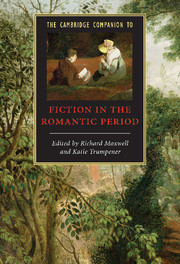Book contents
- Frontmatter
- Introduction
- 1 The historiography of fiction in the Romantic period
- 2 Publishing, authorship, and reading
- 3 Gothic fiction
- 4 The historical novel
- 5 Thinking locally: novelistic worlds in provincial fiction
- 6 Poetry and the novel
- 7 Orientalism and empire
- 8 Intellectual history and political theory
- 9 Women writers and the woman’s novel: the trope of maternal transmission
- 10 Tales for child readers
- 11 Sentimental fiction
- 12 Fiction and the working classes
- 13 The Irish novel 1800-1829
- 14 Scotland and the novel
- Further reading
- Index
- Series List
11 - Sentimental fiction
Published online by Cambridge University Press: 28 January 2009
- Frontmatter
- Introduction
- 1 The historiography of fiction in the Romantic period
- 2 Publishing, authorship, and reading
- 3 Gothic fiction
- 4 The historical novel
- 5 Thinking locally: novelistic worlds in provincial fiction
- 6 Poetry and the novel
- 7 Orientalism and empire
- 8 Intellectual history and political theory
- 9 Women writers and the woman’s novel: the trope of maternal transmission
- 10 Tales for child readers
- 11 Sentimental fiction
- 12 Fiction and the working classes
- 13 The Irish novel 1800-1829
- 14 Scotland and the novel
- Further reading
- Index
- Series List
Summary
Walter Scott's introductory chapter to Waverley: 'Tis Sixty Years Since (1814), with its brief and breezy survey of the possible titles Scott has not chosen for his novel, offers itself as a clearing of the decks for nineteenth-century fiction. Choosing a supposedly unknown and therefore “uncontaminated name” for his hero rather easily, Scott lingers on the “second or supplemental title,” well aware that it will announce the book's generic allegiances and be “held as pledging the author to some special mode of laying his scene.” Scott rejects both “a Tale of Other Days” and “a Romance from the German” because of the Gothic expectations they raise: “would not the owl have shrieked and the cricket cried in my very title-page?” “A Tale of the Times” is also passed over for promising “a dashing sketch of the fashionable world . . . a heroine from Grosvenor Square, and a hero from the Barouche Club or the Four-in-hand.” Scott likewise rejects a “Sentimental Tale” for its promise of a “heroine with a profusion of auburn hair, and a harp, the soft solace of her solitary hours, which she fortunately finds always the means of transporting from castle to cottage.”
Ina Ferris and Katie Trumpener have alerted us to the many ways Scott obscures his debts to other novels in this opening gambit. Dismissing the “sentimental” along with the other major novelistic genres of the day, for example, Scott will proceed to write a novel that shamelessly exploits sentimental conventions and assumptions. Edward Waverley has all the “powers of apprehension,” “brilliancy of fancy,” and “love of literature” that any sentimental heroine could ever desire; Scott persistently places him before picturesque landscapes or outside the main scenes of action, giving Waverley the role of reporting on what he sees and on how it makes him feel; and then there is Flora, a heroine with a harp easily hauled from castle to grotto. Scott often reminds his “fair readers” that he's not writing a “romance” or that Waverley's troubles do not all arise from “sentimental source[s].”
- Type
- Chapter
- Information
- The Cambridge Companion to Fiction in the Romantic Period , pp. 191 - 206Publisher: Cambridge University PressPrint publication year: 2008
- 2
- Cited by



